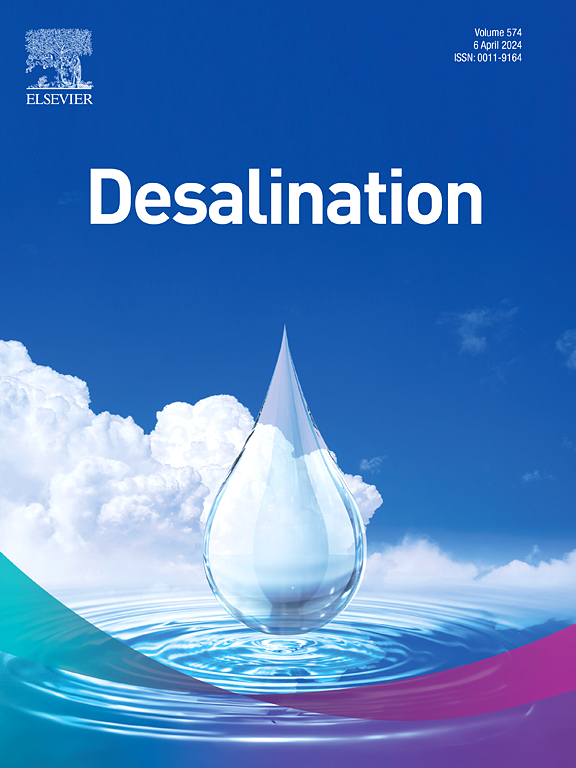从废弃柑橘生物质中提取的用于高性能电容去离子的分层多孔碳质材料
IF 9.8
1区 工程技术
Q1 ENGINEERING, CHEMICAL
引用次数: 0
摘要
电容去离子(CDI)是一种经济、环保的海水淡化方法,通过施加低电压去除盐离子。以低成本、环保和简单的加工方法制备高孔CDI电极材料仍然是一个挑战。本研究利用石灰皮(LP)生物质制备碳,然后在400-1000℃的高温范围内进行KOH活化以提高非晶态形貌和孔隙率。采用热重法、傅里叶变换红外光谱法、x射线衍射法、拉曼光谱法、场发射扫描电镜法、能量色散x射线法和接触角法对制备材料的热稳定性、元素组成、微观态、形貌和亲水性进行了评价。将制备的材料浇铸在石墨电极上,并进行循环伏安法、时电位法和电化学阻抗谱法测量,分析其电容性能。在自制的CDI池中测试了材料对水中离子的去除效率。由于非晶形态、分层多孔结构和优异的润湿性,这些材料在NaCl溶液中普遍表现出较好的电容性能和优异的盐吸附能力。考察了活化剂的使用、炭化温度、CDI实验的流速、盐浓度和施加电压等因素对SAC的影响。在优化条件下,SAC为33.57 mg g−1,伪一阶速率常数约为0.11 min−1。因此,LP是一种潜在的、无成本的碳前驱体,可用于生产廉价、高效、无毒的CDI电极材料。本文章由计算机程序翻译,如有差异,请以英文原文为准。

Hierarchically porous carbonaceous materials derived from waste citrus biomass for high-performance capacitive deionization
Capacitive deionization (CDI) is a cost-effective and environmentally friendly water desalination method that removes salt ions by applying a low voltage. Preparation of highly porous CDI electrode materials from high-abundance sources with low-cost, eco-friendly, and simple processing methods is still challenging. This study used lime peel (LP) biomass to prepare carbon, followed by KOH activation to increase the amorphous morphology and porosity at the elevated temperature range of 400–1000 °C. Thermogravimetry, Fourier-transform infrared spectroscopy, X-ray diffraction analysis, Raman spectroscopy, field-emission scanning electron microscopy, energy dispersive X-ray, and contact angle study was adopted to evaluate the thermal stability, elemental composition, microstates, morphology, and hydrophilicity of the prepared materials. The prepared material was cast on graphite electrodes and subjected to cyclic voltammetric, chronopotentiometric, and electrochemical impedance spectroscopic measurements to analyze their capacitive performance. The ion removal efficiency from the water of the materials was tested in a homemade CDI cell. Owing to the amorphous morphology, hierarchical porous structure, and superior wettability, these materials generally showed better capacitive performance and excellent salt adsorption capacity (SAC) in NaCl solution. The effects of the use of an activating agent and carbonization temperature employed for preparing materials, and the flow rate, salt concentrations, and applied voltage of the CDI experiment on the SAC were revealed. At optimized conditions, the SAC was found to be 33.57 mg g−1 along with a pseudo-first-order rate constant of ca. 0.11 min−1. Thus, LP is a potential, cost-free carbon precursor for producing cheap, efficient, and non-toxic electrode materials for CDI applications.
求助全文
通过发布文献求助,成功后即可免费获取论文全文。
去求助
来源期刊

Desalination
工程技术-工程:化工
CiteScore
14.60
自引率
20.20%
发文量
619
审稿时长
41 days
期刊介绍:
Desalination is a scholarly journal that focuses on the field of desalination materials, processes, and associated technologies. It encompasses a wide range of disciplines and aims to publish exceptional papers in this area.
The journal invites submissions that explicitly revolve around water desalting and its applications to various sources such as seawater, groundwater, and wastewater. It particularly encourages research on diverse desalination methods including thermal, membrane, sorption, and hybrid processes.
By providing a platform for innovative studies, Desalination aims to advance the understanding and development of desalination technologies, promoting sustainable solutions for water scarcity challenges.
 求助内容:
求助内容: 应助结果提醒方式:
应助结果提醒方式:


